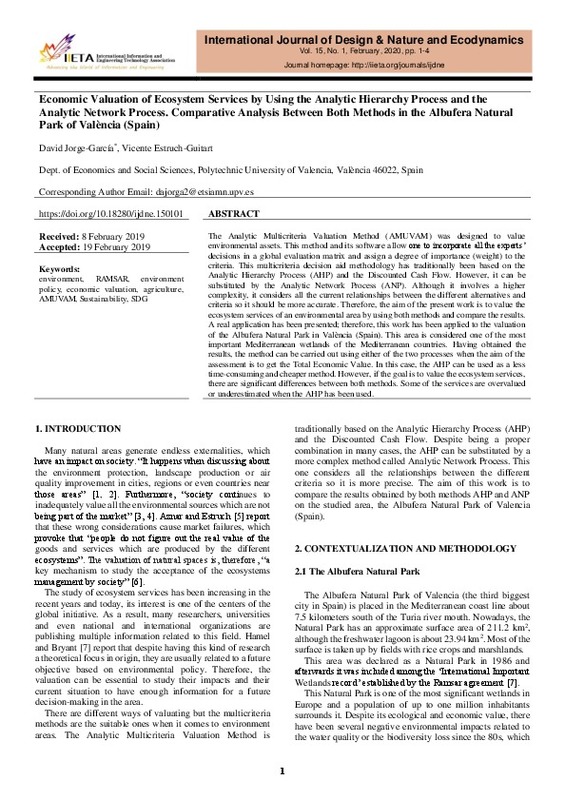JavaScript is disabled for your browser. Some features of this site may not work without it.
Buscar en RiuNet
Listar
Mi cuenta
Estadísticas
Ayuda RiuNet
Admin. UPV
Economic Valuation of Ecosystem Services by Using the Analytic Hierarchy Process and the Analytic Network Process. Comparative Analysis Between Both Methods in the Albufera Natural Park of València (Spain)
Mostrar el registro sencillo del ítem
Ficheros en el ítem
| dc.contributor.author | Jorge-García, David
|
es_ES |
| dc.contributor.author | Estruch-Guitart, Vicente
|
es_ES |
| dc.date.accessioned | 2021-02-16T04:31:50Z | |
| dc.date.available | 2021-02-16T04:31:50Z | |
| dc.date.issued | 2020-02-29 | es_ES |
| dc.identifier.uri | http://hdl.handle.net/10251/161375 | |
| dc.description | Assigned to WIT Press all rights under copyright that may exist in and to the Work and any associated written or multimedia components or other enhancements accompanying the Work. | es_ES |
| dc.description.abstract | [EN] The Analytic Multicriteria Valuation Method (AMUVAM) was designed to value environmental assets. This method and its software allow one to incorporate all the experts' decisions in a global evaluation matrix and assign a degree of importance (weight) to the criteria. This multicriteria decision aid methodology has traditionally been based on the Analytic Hierarchy Process (AHP) and the Discounted Cash Flow. However, it can be substituted by the Analytic Network Process (ANP). Although it involves a higher complexity, it considers all the current relationships between the different alternatives and criteria so it should be more accurate. Therefore, the aim of the present work is to value the ecosystem services of an environmental area by using both methods and compare the results. A real application has been presented; therefore, this work has been applied to the valuation of the Albufera Natural Park in València (Spain). This area is considered one of the most important Mediterranean wetlands of the Mediterranean countries. Having obtained the results, the method can be carried out using either of the two processes when the aim of the assessment is to get the Total Economic Value. In this case, the AHP can be used as a less time-consuming and cheaper method. However, if the goal is to value the ecosystem services, there are significant differences between both methods. Some of the services are overvalued or underestimated when the AHP has been used. | es_ES |
| dc.language | Inglés | es_ES |
| dc.publisher | WITPress | es_ES |
| dc.relation.ispartof | International Journal of Design & Nature and Ecodynamics (Online) | es_ES |
| dc.rights | Reserva de todos los derechos | es_ES |
| dc.subject | Environment | es_ES |
| dc.subject | RAMSAR | es_ES |
| dc.subject | Environment policy | es_ES |
| dc.subject | Economic valuation | es_ES |
| dc.subject | Agriculture | es_ES |
| dc.subject | AMUVAM | es_ES |
| dc.subject | Sustainability | es_ES |
| dc.subject | SDG | es_ES |
| dc.subject.classification | ECONOMIA, SOCIOLOGIA Y POLITICA AGRARIA | es_ES |
| dc.title | Economic Valuation of Ecosystem Services by Using the Analytic Hierarchy Process and the Analytic Network Process. Comparative Analysis Between Both Methods in the Albufera Natural Park of València (Spain) | es_ES |
| dc.type | Artículo | es_ES |
| dc.identifier.doi | 10.18280/ijdne.150101 | es_ES |
| dc.rights.accessRights | Abierto | es_ES |
| dc.contributor.affiliation | Universitat Politècnica de València. Departamento de Economía y Ciencias Sociales - Departament d'Economia i Ciències Socials | es_ES |
| dc.description.bibliographicCitation | Jorge-García, D.; Estruch-Guitart, V. (2020). Economic Valuation of Ecosystem Services by Using the Analytic Hierarchy Process and the Analytic Network Process. Comparative Analysis Between Both Methods in the Albufera Natural Park of València (Spain). International Journal of Design & Nature and Ecodynamics (Online). 15(1):1-4. https://doi.org/10.18280/ijdne.150101 | es_ES |
| dc.description.accrualMethod | S | es_ES |
| dc.relation.publisherversion | https://doi.org/10.18280/ijdne.150101 | es_ES |
| dc.description.upvformatpinicio | 1 | es_ES |
| dc.description.upvformatpfin | 4 | es_ES |
| dc.type.version | info:eu-repo/semantics/publishedVersion | es_ES |
| dc.description.volume | 15 | es_ES |
| dc.description.issue | 1 | es_ES |
| dc.identifier.eissn | 1755-7445 | es_ES |
| dc.relation.pasarela | S\406169 | es_ES |
| dc.subject.ods | 08.- Fomentar el crecimiento económico sostenido, inclusivo y sostenible, el empleo pleno y productivo, y el trabajo decente para todos | es_ES |
| dc.subject.ods | 06.- Garantizar la disponibilidad y la gestión sostenible del agua y el saneamiento para todos | es_ES |
| dc.subject.ods | 15.- Proteger, restaurar y promover la utilización sostenible de los ecosistemas terrestres, gestionar de manera sostenible los bosques, combatir la desertificación y detener y revertir la degradación de la tierra, y frenar la pérdida de diversidad biológica | es_ES |
| dc.subject.ods | 13.- Tomar medidas urgentes para combatir el cambio climático y sus efectos | es_ES |
| dc.subject.ods | 11.- Conseguir que las ciudades y los asentamientos humanos sean inclusivos, seguros, resilientes y sostenibles | es_ES |








